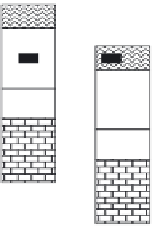Geoscience Reference
In-Depth Information
When minerals are destroyed and when the resultant ions are
exported, it means that the surface of the soil drops. We have seen this
in the example taken above. At times the landscape is lowered.
Globally, one may talk of a
chemical wasting
or
chemical erosion
or
even a
geochemical penetration
and also the slumping of the soil into itself
(a
soil collapse
the Americans say).
A volume of material, imagined to be isolated in the substratum, is
thus progressively caught up and then overtaken by various weathering
fronts representing the appearance of the C, then of the B and lastly, of
the A (Legros 1982). In this concept of the soil, the profile could sink
into itself, without necessarily being modified (Fig. 3.4).
Progressive penetration
A and
Time
Fronts of
appearance
and disappearance
of horizons;
these fronts
progress
downward
Continuous surface
decay +
mechanical
erosion
B
C
This horizontal series of
volumes indicates:
(i) progressive sinking
compared to a reference height,
(ii) successive transfor
horizon to another,
(iii) the genetic phylum of the present-
mation of one
day A
Approximate
current picture
of the genetic
phylum
Reference volume at a given spot height
Portions of horizons roughly serving to
reconstruct the history of the soil
Fig. 3.4
Vertical descent of a profi le as part of the theory of the weathering-front model. The
morphology in this case is totally preserved; it is a limited case intended to make clear the
principle of the model.
Data support this idea of a sort of stable equilibrium (according to
the meaning in physics). For example, the levels of dissolved elements
and their contents in suspended particles have been measured in the
rivers of Central Africa and of Venezuela over a year (Boeglin
et al.
1997; Soler and Lasaga 2000). The former values enable estimation of
the geochemical melting and thence the descent of the base of the soil,














































